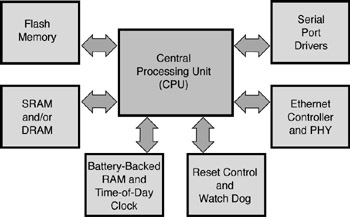System Requirements
| | ||
| | ||
| | ||
The hardware required for an embedded system varies greatly depending on its intended use. Some tiny systems have barely 1K data space and 16K of instruction space, while high-performance systems might run a 1GHz 64-bit processing engine with 32MB CompactFlash and 128MB DRAM. In this book, I focus mostly on systems with capabilities that fall somewhere in the middle. The firmware Ill discuss does require some memory space ( ranging from 32K to 256K of flash memory and 8K to 128K of RAM) depending on what capabilities are built in, so it is not appropriate for small microcontroller (8051, 68HC05/11/12, etc.) projects. On the other hand, this code doesnt need (or want!) a large machine to work successfully.
Figure 1.1 represents a complete system. Using this system model, you can program your own devices, talk to the PC, and even serve HTML pages to a network browser. If you need to skimp, you can eliminate the reset/watchdog and battery- backed -RAM/time-of-day (BBRAM/TOD) clock controller and still have the capabilities I listed! I include these capabilities in our model because they are extremely useful. Theyre also quickly becoming standard equipment on most microprocessor designs.

Figure 1.1: Block Diagram of a Typical Embedded System.
These are the components most common in embedded systems. All embedded systems use some kind of nonvolatile storage (flash memory, EPROM, ROM) and some form of RAM. Most have some channel they can use to communicate with a development host (a serial port, Ethernet port, or JTAG port.).
| | ||
| | ||
| | ||
EAN: 2147483647
Pages: 118